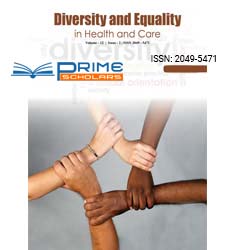Perspective - (2022) Volume 19, Issue 3
To Offer Insights into the Reputation of Racial Disparities in HealthCare.
1Department of Health Services Research, Peking University, China
*Correspondence:
Merita Arini, Department of Health Services Research, Peking University,
China,
Email:
Received: 02-Mar-2022, Manuscript No. IPDEHC-22-13255;
Editor assigned: 04-Mar-2022, Pre QC No. IPDEHC-22-13255;
Reviewed: 18-Mar-2022, QC No. IPDEHC-22-13255;
Revised: 23-Mar-2022, Manuscript No. IPDEHC-22-13255;
Published:
30-Mar-2022, DOI: 10.21767/2049-5471.19.3.12
Introduction
Race and fitness discuss with how identification with a selected
race influences fitness. Race is a complicated idea that has
modified over the years in chronological order and is based
on each self-identity and social cognition. When reading race
and fitness, scientists classify human beings into race classes
primarily based totally on different factors consisting of phenotype,
ancestors, social identification, genetic makeup, and
residing enjoy.
Description
“Race” and ethnicity frequently continue to be undifferentiated
in fitness research. Differences in fitness reputation, fitness results,
lifestyles expectancy, and lots of different signs of fitness
among racial and ethnic corporations are nicely documented.
Epidemiological statistics imply that racial corporations are
unequally suffering from sicknesses, in phrases or morbidity
and mortality. Some people in sure racial corporations obtain
much less care, have much less got right of entry to sources,
and stay shorter lives in general.
Overall, racial fitness disparities look like rooted in social hazards
related to race consisting of implicit stereotyping and
common variations in socioeconomic reputation. In spite of
enormous advances with inside the analysis and remedy of
maximum continual sicknesses, there may be proof that racial
and ethnic minorities generally tend to obtain decrease nice
of care than nonminority’s and that, sufferers of minority ethnicity
enjoy extra morbidity and mortality from numerous continual
sicknesses than nonminority’s. The Institute of Medicine
file on unequal remedy concluded “racial and ethnic disparities
in healthcare exist and, due to the fact they may be related to
worse results in lots of cases, are unacceptable.” 1 The IOM file
described disparities in fitness care as “racial or ethnic variations
with inside the nice of fitness care that aren’t because of
access related elements or scientific needs, preferences, and appropriateness of intervention.” Since the booklet of the IOM
file there was renewed hobby in knowledge the reasserts of
disparities, figuring out contributing elements, and designing
and comparing powerful interventions to lessen or put off racial
and ethnic disparities in fitness care.
In 1965, the Medicare software changed into created to lessen
monetary boundaries to hospitals and scientific offerings for
human beings over the age of 65. To take part on this software,
hospitals have been required to conform to Title VI of the Civil
Rights Act of 1964. Under this law, you’ll now no longer be disqualified
from federal offerings primarily based totally on race,
colour, or United States of America of origin. This requirement
performed a chief position with inside the separation of hospitals.
Using statistics to discover inequality and the elements
that force it’s far essential to manual sources and efforts to put
off them and to evaluate development toward extra fairness
over the years. To offer insights into the reputation of racial
disparities in healthcare and healthcare, this evaluation examines
how coloured human beings are in comparison to whites
in phrases of healthcare intervention; get right of entry to, and
use.
Conclusion
Health reputation, effects and behaviour; social determinants
of fitness. When possible, we gift statistics from six racial /
ethnic corporations: Whites, Asians, Hispanics, Blacks, Native
Americans, Alaska Natives, Native Hawaiians, and different
Pacific Islands. Hispanics may be of any race, however on this
evaluation they may be categorised as Hispanic. Other corporations
are restrained to the ones diagnosed as non-Hispanic.
Acknowledgement
None.
Conflict of Interest
The author’s declared that they have no conflict of interest.
Citation: Arini M (2022). To Offer Insights into the Reputation of Racial Disparities in Healthcare. Diversity & Equality in Health
and Care. 19:12
Copyright: © Arini M. This is an open-access article distributed under the terms of the Creative Commons Attribution License,
which permits unrestricted use, distribution, and reproduction in any medium, provided the original author and source are
credited

